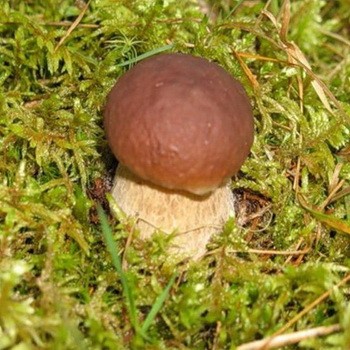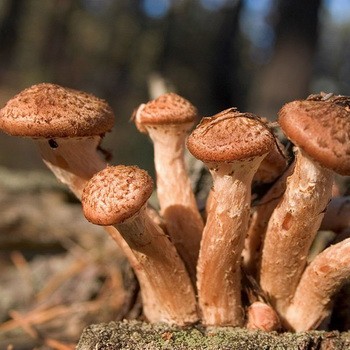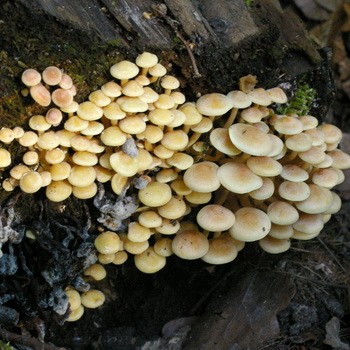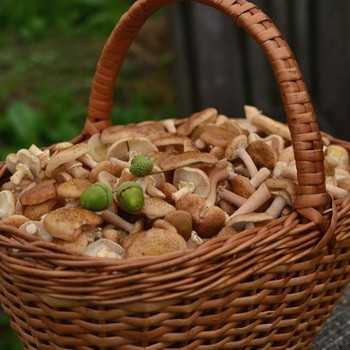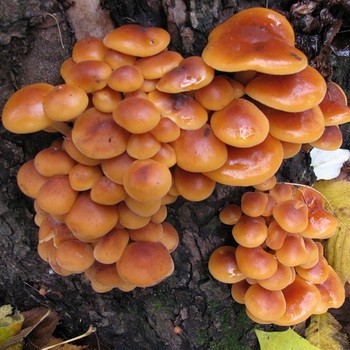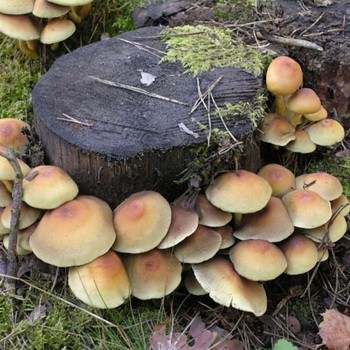Time and growth conditions of mushrooms in the forest
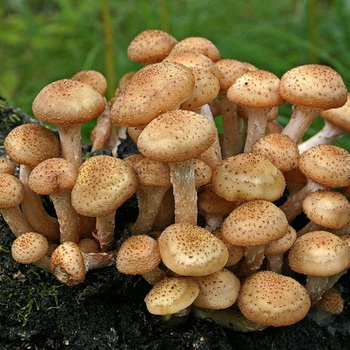
But before you get to our table, honey mushrooms still need to be found in the forest. Many are familiar with where and how to collect data from fruiting bodies. However, few people know about the growth time of mushrooms. So, if we consider that all honey mushrooms are divided into spring, summer, autumn and winter species, then their growth affects the corresponding seasons. However, this is just general information that is unlikely to bring much benefit. You need to know how quickly mushrooms grow in the forest, and what weather will be conducive to this. Guided by this information, it is possible to significantly increase not only the quality, but also the amount of the mushroom crop harvested.
Content
- What weather is needed for the growth of honey agarics: optimal temperature
- Conditions for the growth of spring, summer and autumn mushrooms in the forest (with video)
- The growth period of autumn mushrooms: how quickly mushrooms grow in September after cutting
- How quickly do honey mushrooms grow in the fall after rain?
- How quickly mushrooms grow in October and the time of growth of winter mushrooms
What weather is needed for the growth of honey agarics: optimal temperature
Everyone knows that honey agarics grow in large colonies, settling on rotten stumps and fallen trees. To meet such a friendly “family” on its way is a real success. However, it happens that when we come into the forest, we stumble upon a meager harvest of overgrown mushrooms. Most likely, this is due to inappropriate weather conditions, as well as the choice of the wrong time for going for fruiting bodies. In this case, you need to know what weather is needed for the growth of honey agarics. Such information will help you determine as accurately as possible when to go on a "silent hunt."
What temperature is considered optimal for the growth of honey mushrooms in the forest? It must be said that temperature is one of the most important factors affecting the growth of fruiting bodies. So, for most fungi, including some species of honey mushrooms, the average temperature of abundant growth and fruiting is + 15-26 ° C. However, spores of autumn, spring and winter mushrooms begin to grow already at a temperature of + 3-5 ° C. But the high air temperature negatively affects the growth of fruiting bodies. So, at + 30 ° C and higher, the growth processes completely stop, and if drought is also observed, then the mushrooms begin to dry out and deteriorate. In addition, a sharp and strong fluctuation in day and night temperatures also greatly slows down the growth of honey agarics.
Conditions for the growth of spring, summer and autumn mushrooms in the forest (with video)
We can say that for summer mushrooms the most suitable temperature is + 23 ° C, and for autumn and spring - + 12 ° C. However, this is not all weather conditions, allowing abundant fruiting of mushrooms. So, we smoothly moved, perhaps, to the most important condition necessary for the growth of honey agarics in the forest.Good humidity combined with optimal air temperature creates excellent soil for the “rich” harvests of these fruiting bodies. It often happens that honey mushrooms can bear fruit abundantly as many times as torrential rains pass during the season.
For the growth and development of mycelium, a regular flow of air is also needed. In most cases, mycelium passes through the upper layers of the soil and deepens by 6-13 cm. If adverse weather is established - severe drought, frost, hardening of the soil, excessive humidity, then it begins to develop poorly and dehydrate, but this does not affect its stability. For optimal growth and development of honey agarics, the air humidity in the upper layers of the soil should be from 50 to 65%.
Thus, it becomes apparent that favorable weather for the growth of honey agarics includes heat and moisture. And what about the growth rate of honey mushrooms? Unfortunately, there is no single answer to this question, because a number of factors influence the process. Even experienced mushroom pickers are not able to give specific numbers.
We often use the phrase "grow like mushrooms" in our speech. As you can see, this process is fast enough. It is noteworthy that the growth of the legs of the fruiting body stops 1-2 days earlier than the growth of the cap. Unfavorable weather, as well as the presence of insects or worms, significantly weaken the growth of fungi.
On the other hand, good conditions enable the fruiting body to grow significantly in 24 hours. And what about mushrooms - how quickly do these mushrooms grow in a day? Like other representatives of the mushroom "kingdom", honey mushrooms can increase in size by 1.5-2 cm. But as already mentioned, these figures are approximate and cannot create any specific framework. The life span of mushrooms is determined by their variety; on average, these indicators range from 10 to 15 days. So, honey mushrooms completely cease their growth after 11 days. We offer you to watch a video showing the growth of honey mushrooms due to faster shooting:
The growth period of autumn mushrooms: how quickly mushrooms grow in September after cutting
Among all species of honey mushrooms, autumn is considered the most popular. For the active fruiting of these fruiting bodies, there is also a favorable “atmosphere”. Many mushroom pickers are very fond of collecting these mushrooms, because by taste they belong to the 3 category. They make very tasty and fragrant dishes, as well as preparations for the winter. So, the growth period of autumn honey agarics captures the last days of August, lasts throughout September and ends in mid-October. The peak of growth is observed in September with the onset of the first rains.
Many people wonder how quickly honey mushrooms grow in September, so as not to “miss” the moment of going to the forest. I must say that autumn honey agarics grow even faster than representatives of other species. If the remaining fruiting bodies reach large sizes in 9-12 days, then autumn mushrooms grow up in 6-8. However, the growth rate of mushrooms in autumn also depends on a number of factors. For example, for abundant growth, favorable weather is necessary - an average temperature of + 12 ° C (slight differences in daytime and nighttime indicators are allowed), as well as moderate rainfall. In addition, the condition of a stump or tree also affects growth and fruiting. So, if the wood is completely rotten, then the growth rate of honey agarics increases. The fact is that in such stumps a greater flow of air and moisture opens, which means that mushrooms grow faster.
Many mushroom pickers with experience note that autumn mushrooms are ready for harvesting in 1.5-3 days. If today you find a stump where you can barely see them, then feel free to come to this place tomorrow. Fruit bodies will be ready to go to your basket. In addition, autumn species of honey agarics breed also quite quickly. Within a day, a large number of representatives of the mushroom "kingdom" can be found on an empty stump or tree. Mycologists say that already on the second day the autumn wrap reaches 5 cm in length and the diameter of the hat is about 2 cm. After another 2-3 days, these figures increase by 1.5 cm.Then the leg slows in growth, and the hat continues to grow. On the last day of life, the honey agaric (day 10), the leg reaches 9-14 cm in height, and the cap has a diameter of more than 8 cm
Some fans of the “silent hunt” ask how quickly mushrooms grow after cutting? Here you can also wait 2-3 days, and again go to the place where you have already harvested.
I must say that all the mushrooms, having completed fruiting, the very next day begin to age and collapse. This process is very rapid, however, autumn species in this case have an advantage. They age more slowly, retaining their elasticity and flesh longer. This is due to cool weather, as well as sufficient humidity.
How quickly do honey mushrooms grow in the fall after rain?
And how quickly do honey mushrooms grow in the fall after rain? In this case, the first 2-3 days after the last drop falls on the soil are the most suitable for hiking in the forest. It was established that the greatest growth rate of honey agarics occurs precisely in the first days after rain. With this in mind, you can correctly calculate the time when you can go to the forest for a new crop.
In addition, fogs, which can be observed throughout September and October, are another favorable phenomenon for the growth of autumn mushrooms. Frequent fogs also have a very beneficial effect on the "wealth" of mushroom crops, because the soil is saturated with enough moisture. In this case, it recommends planning a trip to the forest in the early morning, when the sun has not yet had time to illuminate it with direct rays.
How quickly mushrooms grow in October and the time of growth of winter mushrooms
And what can be said for October - how quickly mushrooms grow this month? First of all, you need to consider the local climate. Sometimes autumn species of honey mushrooms can be found even in early November, if the weather allows. But in the month of October there is an abundant growth of fruiting bodies during the onset of the so-called “Indian summer”. At this time, after the first frost, a thaw comes for a few days, which means abundant growth of mushrooms. And as already noted, it is heat and humidity that are the main conditions for the growth of autumn mushrooms. 2-3 days after the start of warm days, you can safely go in search of a new crop.
But for the winter species of honey mushrooms, the weather needs a completely different, because they collect them throughout the winter. How fast do winter mushrooms grow in the forest? Interestingly, they grow even when the air temperature reaches + 7 ° C. Despite this, their growth rate is no different from other species of honey mushrooms. In contrast, winter mushrooms are not afraid of frost, but only covered with ice crust. Then, with the onset of the thaw, they come to life and continue to grow, while maintaining their pristine appearance and elasticity.
